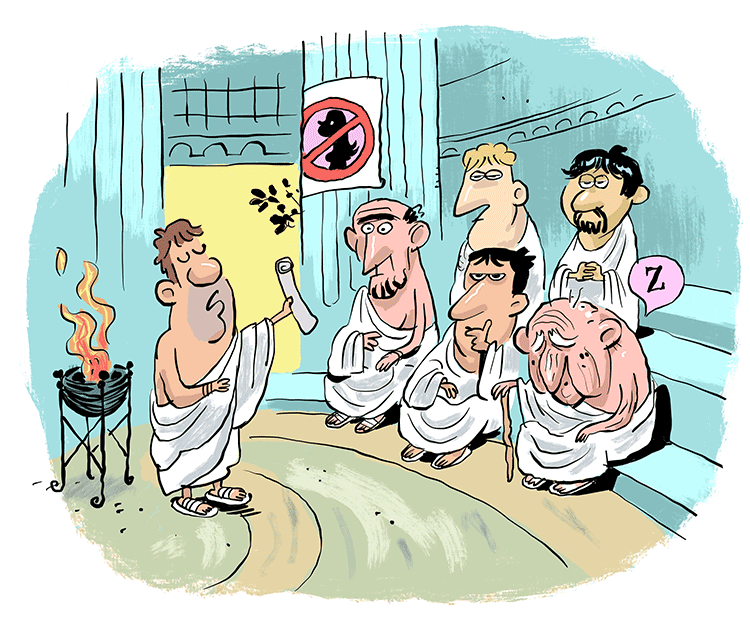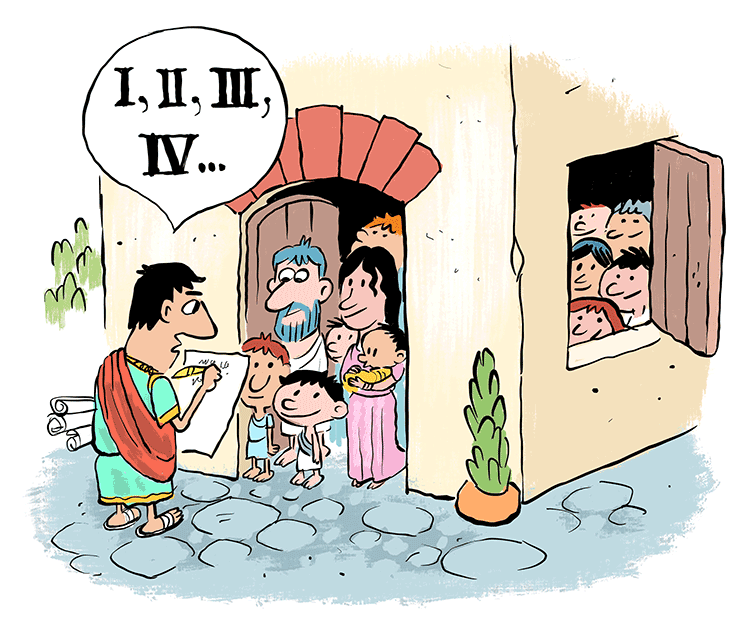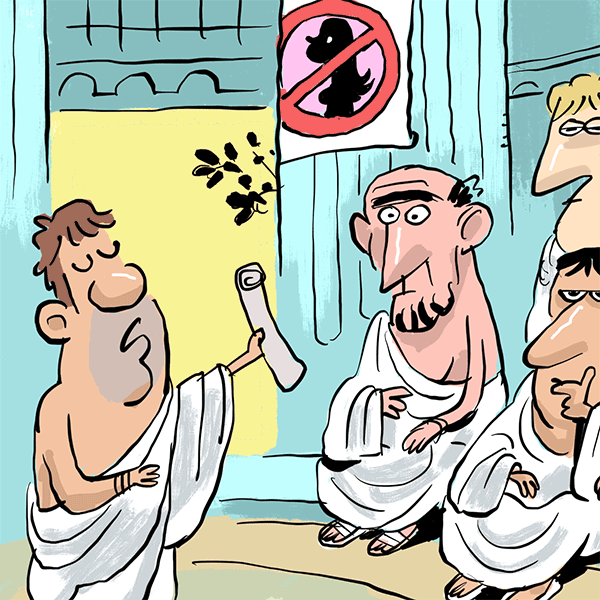Today, the most common form of government in the world is the republic. To run their governments, people elect representatives to make laws on their behalf, instead of voting on issues directly, as in a democracy.
The word “republic” comes from the Latin res publica, which literally translates to “public thing.” But it’s not just the name that modern governments get from The City of Seven Hills. Most modern governments are structured in a way that is very similar to what existed in ancient Rome.

The Change from a Kingdom to a Republic
In the early days of Rome, from around 900 to 500 BC, Rome was ruled by kings. But as the city grew, there were more and more powerful people around. But since they weren’t kings, they didn’t have much say in what happened to the city.
After a while, this got old, and in 507 BC, a group of powerful people in Rome decided to overthrow the king. But they couldn’t just leave Rome without a ruler, and they also couldn’t agree on just one person to rule, so they turned control of Rome over to the Senate, an elected body made up of Roman citizens.
The Senate had existed since the founding of Rome as an important advisory council to the king. But in 507 BC, it became top dog and was charged with guiding Rome in all its domestic and international affairs.
In the end, while this also made Rome more democratic, it created a number of problems as the city grew and expanded its influence: corruption and in-fighting rocked Roman stability and ultimately opened the door for its eventual transition to a full-blown military dictatorship and empire.
How Did the Roman Republic Work
In a Republic, the power rests with the people. But unlike a democracy, where each person must vote on all matters of the state, in a republic, the people elect representatives to vote on their behalf.
They also vote on an individual leader to help conduct the affairs of the state.
In Roman times, these were the consuls. Today, we have presidents and prime ministers.
The early Roman republic operated along these guidelines, but it was also a complex web of political positions that wound up competing with one another for control of Rome.
Roman Magistrates
The most famous component of the Roman republic was the Senate. But while powerful, the ones really running Rome were the magistrates, the name used for elected officials.
At the top of this political pyramid was a dictator. But this was a temporary position, one the Senate appointed only in times of emergencies.
During normal times, the consuls, of which there were two, ran Rome. They were elected every year by the Senate and were responsible for commanding the army and providing for the welfare of Roman citizens.
Below the consuls were the praetors, the aediles, and, finally, the quaestors.
These individuals were elected by the people of Rome. Their duties ranged from overseeing criminal and civil courts (praetors) to assisting in the financial matters of important generals or provincial governors.
Each magistrate served a one-year term, and once their time in office was done, they could not run again for ten years.
To keep them from getting too much power, the magistrates had to follow the advice of the Senate, as well as the countless rules and regulations that defined their powers, all of which dated back to the early days of Rome.
All in all, while glamorous, being a magistrate was not easy.

The Senate
Established by Romulus, the first king of Rome, the Roman Senate could trace its roots to the beginning of the city, and it used this history to uphold its power. Its original members were the most wealthy and powerful people in Rome who weren’t members of the royal family.
Once elected, Senators were in the Senate for life. And they also didn’t get paid, which meant you pretty much had to be wealthy to join.
In this sense, the Senate was a grouping of Rome’s richest and most powerful men. Women weren’t allowed.
The job of the Senate was to manage Rome, though it spent most of its time and focus on foreign policy, or, shall we say, waging wars of conquest in faraway lands.
To do this, the Senate passed senatus consulta, which was technically “advice” to the magistrates. Though it was custom for magistrates to follow these as orders.
If things got crazy, the Senate could pass resolutions that granted magistrates certain powers. For example, only the Senate could appoint dictators, who wielded unmatched power in Rome.
Joining the Senate
Senators weren’t exactly elected, at least not directly by the people. Instead, they were appointed once they’d accomplished enough in politics, business, war, or a combination of all three, to become worthy.
Honor, prestige, and esteem were big parts of making it to the Senate. You had to be someone to be invited in. Not unlike a secret club.
At first, the consuls appointed the Senators. But later in history, the position of censor was created. Among other things, this person was responsible for overseeing the Senate and adding or removing members as they saw fit.
A law was also passed in 318 BC that said that all elected magistrates had to be appointed to the Senate, which significantly opened up access to the legislative body
Also in the early days, only members of Rome’s upper class — the patricians — could join the Senate. But reforms opened it up to all Roman citizens — the plebeians — not too long after the overthrow of the monarchy.
Being a Senator was a prestigious job, but it was also a lifetime one. You’d be expected to serve until you were too old to perform.
The Comitas
Although the Senate, and by extension the Consuls, held a lot of the power in Rome, they were not free to do as they pleased: they had to answer to the Assemblies, or the Comitas.
These were smaller legislative bodies that were elected from different groups of people, such as the Centuriate Assembly, which was made up of soldiers, and the Tribal Assembly, which was made up of the elected officials of the tribes, or the districts, of Rome.
The Comitas were also responsible for overseeing judicial cases, as well as for enacting laws and electing other government officials.
In the beginning, the Assemblies were arms of the Senate. But as Rome grew, the Assemblies gained more and more power, eventually eroding the position of the Senate and making the transition to military dictatorship possible.
They did this by electing Tribunes, which were not quite magistrates but close. But they had the power to veto decisions made by the consuls, which was an important check on their power.
By grouping people into different geographical regions and determining representation using population, these Roman assemblies laid the groundwork for how modern republics function, such as that of the United States.

The Censors
Another change came with the creation of the censors. These magistrates, elected by the Senate, had tremendous influence over the Roman state. Their primary task was to periodically count the population of Rome and its property, so as to determine tax revenues.
Beyond that, though, the censors would use this information to determine the tribes, which would impact who could get elected to the Assemblies, and also make changes to the Senate. They could grant membership to new people if they deem they qualify, and they could also remove any members they saw no longer fit for office.
Censors could not exercise these powers all the time. But just having them gave them tremendous influence over Rome and its affairs.
Eventually, as Rome grew, many of those in power chose to pursue their ambitions by appealing to the people, which eroded the power of the senate and eventually made it possible for the Roman empire to emerge.
A Complex System of Checks and Balance
Throughout the history of ancient Rome, the specific structure of the Roman republic changed. New bodies were created, new positions were made, and rules were changed to allow more people to have a say in the government.
The purpose of all of this? To prevent any one person from gaining too much power. Rome overthrew its monarchy for a reason, and it sought to protect its democracy by establishing a system that would keep power spread out amongst many different people.
It’s for this very same reason that most modern governments are set up in the way that they are. In fact, when crafting the US Constitution, the delegates drew upon Roman history for their creation, and this model has been duplicated across the world.
Of course, it doesn’t always work out this way. It didn’t even pan out correctly in Rome. Eventually, power fell into the hands of a small group, leading to dictatorship and empire. But this example has stood the test of time and continues to be one of the most effective forms of government in the world.
Written by Matthew Jones
Illustrated by Jean Galvao
